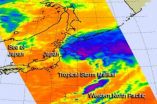(Press-News.org) Researchers have discovered a star that whips around the giant black hole at the center of our galaxy in record time, completing an orbit every 11.5 years. The finding, appearing today in the journal Science, points ahead to groundbreaking experiments involving Einstein's general theory of relativity. Those tests will be fully enabled by the Thirty Meter Telescope (TMT), slated to begin observations next decade.
The record-setting star, called S0-102, was detected with the twin 10-meter telescopes at the W.M. Keck Observatory in Hawaii. For the past 17 years, the telescopes have imaged the galactic core, where a team of astronomers have hunted for stars with short orbital periods. These stars offer a never-before-possible test of how a supermassive black hole's gravity warps the fabric of space-time.
"The discovery of S0-102 is a crucial ingredient for our ultimate goal of revealing the fabric of space-time around a black hole for the first time," said Andrea Ghez, leader of the team and a professor of physics and astronomy at the University of California, Los Angeles and who is a member of the TMT project's Science Advisory Committee
Although Keck is among the most advanced astronomical instruments now in operation, it will require the future power of TMT and its adaptive optics system to put Einstein's theory through its paces.
"In order to test the heart of relativity, Einstein's equations, we have to wait for the next major technological breakthrough: TMT with its multi-conjugate adaptive optics system," said Leo Meyer, a member of Ghez' team and lead author of the new paper. Meyer, along with co-authors Sylvana Yelda and Tuan Do, is part of TMT's astrometry working group that studies the unique capabilities of TMT to observe the motion of the faintest objects in the universe.
"It is amazing to think about what TMT will be capable of," said Ghez.
TMT's adaptive optics system builds on those presently employed by premier observatories including Keck, Gemini, and the Very Large Telescope. Adaptive optics helps ground-based telescopes collect sharper images by compensating for the distorting effects of atmospheric turbulence. The systems rely on deformable mirrors and lasers that create "guide stars" in the sky to provide reference points for keeping observations in focus.
The adaptive optics designed for TMT, along with its huge primary mirror, will provide breakthroughs on many fronts, Ghez explained. On TMT, the angular resolution – the ability to see fine details – will be three times sharper than that of Keck. But the gain in astrometric, or tracking precision of individual stars in a crowded region like the center of our Galaxy will be at least a factor of 10. It is also conceivable that TMT will find stars that are even more tightly bound to the Milky Way's central black hole than S0-102.
Like Keck, TMT will track the motion of stars, such as S0-102, that have elliptical (oval-shaped) orbits. The orbits bring the stars periodically closer to the black hole. This proximity, coupled with TMT's precision, will allow for two key tests of relativity.
In the first, a star deep in the gravity well of a black hole should have its light be stretched out, or redshifted, to a certain degree, and have its orbit deviate from a perfect ellipse. A second aspect of the deviation should reveal that the stars' orbits experience precession, or a slight shifting, creating a flower-shaped pattern of orbits around the black hole over time. The deviations will speak to the validity of the actual equations underpinning general relativity.
Researchers know that at the heart of a black hole, Einstein's general theory of relativity should begin to break down. Should some of the results gleaned by TMT not match with the venerated theory, a new window would open into how gravity fundamentally works at all scales of the universe, from the grandest to the smallest.
"As strong a theory as general relativity is for large-scale phenomena, we do not know how to reconcile it with quantum mechanics, the theory that describes phenomena on atomic and subatomic scales," said Ghez. "One reason, therefore, that we want to build TMT is to delve into the most fundamental workings of our universe."
INFORMATION:
TMT is the next-generation astronomical observatory that is scheduled to begin scientific operations in 2021 on Mauna Kea, Hawaii. TMT is a collaboration of the California Institute of Technology, University of California, the Association of Canadian Universities for Research in Astronomy, the National Astronomical Observatory of Japan, a consortium of Chinese institutions led by the National Astronomical Observatories of the Chinese Academy of Sciences, and institutions in India supported by the Department of Science and Technology of India.
TMT will take discoveries of stars orbiting the Milky Way's monster black hole to the next level
2012-10-05
ELSE PRESS RELEASES FROM THIS DATE:
Story tips from the Department of Energy's Oak Ridge National Laboratory, October 2012
2012-10-05
ELECTRICITY-- Spotlight on outages . . .
When a storm knocks out power, among the first questions to be answered are how many people are affected and when electricity will be restored. Oak Ridge National Laboratory's Energy Awareness and Resiliency Standardized Services application, or EARSS, uses publicly available data and can help by showing grid status in real time. The goal is to enhance situational awareness for the emergency response community, according to EARSS co-developer Steve Fernandez of ORNL's Computational Sciences and Engineering Division. "Working from ...
Researchers find ancient carbon resurfacing in lakes
2012-10-05
RICHMOND, Va. (Oct. 4, 2012) – A new study reveals that a significant amount of carbon released into the atmosphere from lakes and rivers in Southern Québec, Canada, is very old – approximately 1,000 to 3,000 years old – challenging the current models of long-term carbon storage in lakes and rivers.
Previous studies have suggested that there is a tight coupling between the terrestrial and aquatic environment such that aquatic bacteria rapidly consume modern carbon. The new findings of the respiration of old carbon in aquatic systems suggests there may be significant lags ...
Northern conifers youngest of the species
2012-10-05
New Haven, Conn.—Dramatic shifts in the planet's climate and geography over millions of years changed the course of evolutionary history for conifer trees, according to a Yale paper in the Proceedings of the National Academy of Sciences.
Yale researchers examined the fossil record and genetic makeup of 489 out of more than 600 living conifer species and discovered that while most conifers belong to ancient lineages, most Northern Hemisphere species, including the majority of pines and spruces, appeared within the past 5 million years.
They argue that the migration ...
Researchers reveal how solvent mixtures affect organic solar cell structure
2012-10-05
Controlling "mixing" between acceptor and donor layers, or domains, in polymer-based solar cells could increase their efficiency, according to a team of researchers that included physicists from North Carolina State University. Their findings shed light on the inner workings of these solar cells, and could lead to further improvements in efficiency.
Polymer-based solar cells consist of two domains, known as the acceptor and the donor layers. Excitons, the energy particles created by solar cells, must be able to travel quickly to the interface of the donor and acceptor ...
Improving confidence keeps breast cancer survivors exercising
2012-10-05
CORVALLIS, Ore. – More than 40 percent of older breast cancer survivors are insufficiently active after leaving a supervised program. But new research shows that those women who developed behavioral skills such as self-confidence and motivation during their program were far more likely to continue exercising on their own.
Regular exercise may reduce the risk of breast cancer recurrence and breast cancer-related mortality, experts say, making it crucial to effectively target breast cancer survivors who do not engage in regular physical activity for interventions.
Researchers ...
Why we need insects -- even 'pesky' ones
2012-10-05
At first blush, many people would probably love to get rid of insects, such as pesky mosquitoes, ants and roaches. But a new study indicates that getting rid of insects could trigger some unwelcome ecological consequences, such as the rapid loss of desired traits in plants, including their good taste and high yields.
Specifically, the study--described in the Oct. 5, 2012 issue of Science and funded by the National Science Foundation showed that evening primroses grown in insecticide-treated plots quickly lost, through evolution, defensive traits that helped protect them ...
MU researcher identifies factors to help parents and professionals recognize teens in distress
2012-10-05
Suicide is the third-leading cause of death for teens, according to the Centers for Disease Control and Prevention. Now, a University of Missouri public health expert has identified factors that will help parents, medical professionals and educators recognize teens at risk for self injury and suicide.
"For many young people, suicide represents an escape from unbearable situations—problems that seem impossible to solve or negative emotions that feel overwhelming," said Lindsay Taliaferro, an assistant professor of health sciences at MU. "Adults can help these teens dissect ...
Sandia Labs benchmark helps wind industry measure success
2012-10-05
ALBUQUERQUE, N.M. – Sandia National Laboratories published the second annual 2012 Wind Plant Reliability Benchmark on Monday, and the results should help the nation's growing wind industry benchmark its performance, understand vulnerabilities and enhance productivity.
Until now, wind farm owners and operators had no way to compare their output with the output of similar operations. To benchmark the reliability of the U.S. wind turbine fleet and identify major causes of failures and downtime, the DOE commissioned Sandia in 2010 to build the Continuous Reliability Enhancement ...
Far, far beyond wrist radios
2012-10-05
To believe that technologies once dreamed of in science fiction novels, television shows, and comic strips may one day be a reality, or that real-world technologies might make the fantastic devices of fiction obsolete, you'd need to be either an optimist…or a futurist in the Department of Homeland Security (DHS)'s Science and Technology Directorate (S&T).
To keep dreams grounded, S&T maintains a team of futurists in Arlington, Va., at the Homeland Security Studies & Analysis Institute (HSSAI). There, in the Resilience and Emergency Preparedness / Response Branch, analysts ...
NASA sees Tropical Storm Maliksi put final touches on Japan
2012-10-05
Tropical Storm Maliksi is putting the final touches on Japan, that is, the edge of the storm was seen brushing the country's northern coast as it pulled away on NASA satellite imagery.
NASA's Aqua satellite passed over Tropical Storm Maliksi on Oct. 4 at 0329 UTC (11:29 p.m. EDT, Oct. 3, EDT) and the Atmospheric Infrared Sounder (AIRS) instrument captured an infrared image of the storm brushing the Tohoku and Hokkaido prefectures of northern Japan.
On Oct. 4, 2012 at 1500 UTC (11 a.m. EDT), the Joint Typhoon Warning Center issued their final advisory on Maliksi. At ...






